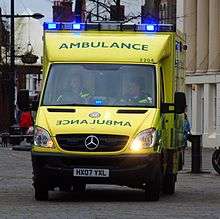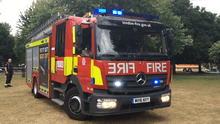Emergency service
Emergency services and rescue services[1] are organizations which ensure public safety and health by addressing different emergencies. Some of these agencies exist solely for addressing certain types of emergencies whilst others deal with ad hoc emergencies as part of their normal responsibilities. Many of these agencies engage in community awareness and prevention programs to help the public avoid, detect, and report emergencies effectively.

The availability of emergency services depends very heavily on location, and may in some cases also rely on the recipient giving payment or holding suitable insurance or other surety for receiving the service.
Emergency services

There are three primary emergency services that can be summoned directly by the public:
- Police — law enforcement, criminal investigation, and maintenance of public order.
- Fire — firefighting, hazardous materials response, and technical rescue.
- EMS — emergency medical services and technical rescue
Emergency services have one or more dedicated emergency telephone numbers reserved for critical emergency calls. In some countries, one number is used for all the emergency services (e.g. 911 in the U.S., 999 in the UK). In some countries, each emergency service has its own emergency number.
Specialized emergency services
These services can be provided by one of the core services or by a separate government or private body.
- Emergency management — incident management and coordination.
- Tactical teams (e.g. SWAT) — hostage rescue and counter-terrorism operations and high-risk arrests.
- Hazardous Devices Team/Public Safety Bomb Disposal
- Public Safety Dive Teams/Maritime Units
- Canine Units — drug detection, explosive detection, cadaver detection, arson and accelerant detection, search and rescue, evidence search, suspect apprehension, and handler protection.
- Aviation Units — law enforcement, firefighting, emergency medical services and technical rescue, and emergency management functions.
- Fire fighting Units
- Hazardous Materials — hazardous materials mitigation
- Search and Rescue
- Wildland firefighting
- Military
- Incident response team
- Corrections and community services
Other emergency services
These groups and organizations respond to emergencies and provide other safety-related services either as a part of their on-the-job duties, as part of the main mission of their business or concern, or as part of their hobbies.
- Public utilities — safeguarding gas, electricity and water, which are all potentially hazardous if infrastructure fails
- Public Works — assessing and repairing damage to buildings, roads, and bridges; clearing, removing, and disposing of debris from public spaces; restoring utility services; and managing emergency traffic.
- Emergency road service — provide repair or recovery for disabled or crashed vehicles
- Civilian Traffic Officers — such as operated by the Highways Agency in the UK to facilitate clearup and traffic flow at road traffic collisions
- Emergency social services
- Community emergency response teams — help organize facilities such as rest centers during large emergencies
- Disaster relief — such as services provided by the Red Cross and Salvation Army
- Famine relief teams
- Amateur radio communications groups — provide communications support during emergencies
- Poison Control — providing specialist support for poisoning
- Animal control — can assist or lead response to emergencies involving animals
- Voluntary medical services — medical & first aid support. Providers of these services include: St. John Ambulance / Red Cross / Order of Malta Ambulance Corps.
- Insurance damage: fixes flooded and fire damaged buildings.
- Tri- service: these units respond to police, medical and fire incidents.
Location-specific emergency services
Some locations have emergency services dedicated to them, and whilst this does not necessarily preclude employees using their skills outside this area (or be used to support other emergency services outside their area), they are primarily focused on the safety or security of a given geographical place.
- Lifeguards — charged with reacting to emergencies within their own given remit area, usually a pool, beach or open water area
- Park rangers — looking after many emergencies within their given area, including fire, medical and security issues
- Ski patrol — provides emergency medical care and rescue services within their area, such as a ski resort or backcountry.
- first aid or medic - respond to medical issues and maybe hired for businesses or events
Cooperation
.jpg)
Effective emergency service management requires agencies from many different services to work closely together and to have open lines of communication. Most services do, or should, have procedures and liaisons in place to ensure this, although absence of these can be severely detrimental to good working. There can sometimes be tension between services for a number of other reasons, including professional versus voluntary crew members, or simply based on area or division. To aid effective communications, different services may share common practices and protocol for certain large-scale emergencies. In the UK, commonly used shared protocols include CHALET and ETHANE while in the US, the Department of Homeland Security has called for nationwide implementation of the National Incident Management System (NIMS),[2] of which the Incident Command System (ICS) is a part.[3]
Disaster response technologies
Smart Emergency Response System (SERS)[4] prototype was built in the SmartAmerica Challenge 2013-2014,[5] a United States government initiative. SERS was created by a team of nine organizations. The project was featured at the White House in June 2014 and called an exemplary achievement by Todd Park (U.S. Chief Technology Officer).
The SmartAmerica initiative challenges the participants to build cyber-physical systems as a glimpse of the future to save lives, create jobs, foster businesses, and improve the economy. SERS primarily saves lives. The system provides the survivors and the emergency personnel with information to locate and assist each other during a disaster. SERS allows organization to submit help requests to a MATLAB-based mission center connecting first responders, apps, search-and-rescue dogs, a 6-feet-tall humanoid, robots, drones, and autonomous aircraft and ground vehicles. The command and control center optimizes the available resources to serve every incoming requests and generates an action plan for the mission. The Wi-Fi network is created on the fly by the drones equipped with antennas. In addition, the autonomous rotorcrafts, planes, and ground vehicles are simulated with Simulink and visualized in a 3D environment (Google Earth) to unlock the ability to observe the operations on a mass scale.[6]
Response time
A common measurement in benchmarking the efficacy of emergency services is response time, the amount of time that it takes for emergency responders to arrive at the scene of an incident after the emergency response system was activated. Due to the nature of emergencies, fast response times are often a crucial component of the emergency service system.[7]
See also
- Civil Air Patrol
- Civil defense
- Common Alerting Protocol
- Emergency management
- Emergency service response codes
- Incident response team
- Public safety
- Rescue squad
Sources
- "Rescue services definition and meaning - Collins English Dictionary". www.collinsdictionary.com. Retrieved 19 March 2018.
- Federal Emergency Management System: About NIMS Archived 2011-09-25 at the Wayback Machine
- Federal Emergency Management System: Incident Command System Archived 2011-09-23 at the Wayback Machine
- Smart Emergency Response System , team website.
- SmartAmerica Challenge , website.
- Video Smart Emergency Response System
- Davis, Robert (20 May 2005). "The price of just a few seconds lost: People die". USA Today. Retrieved 5 February 2013.